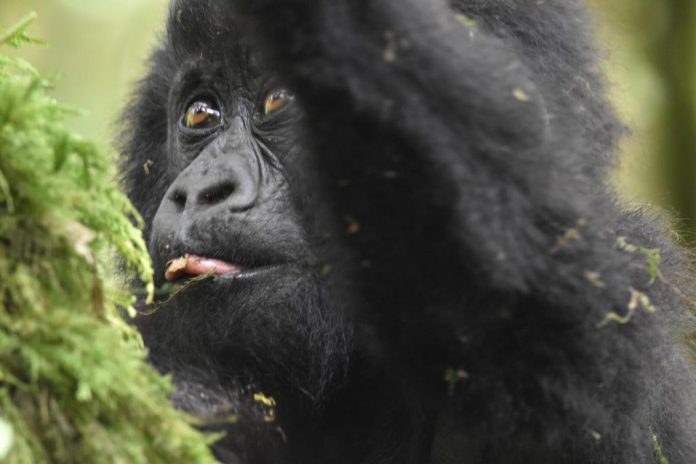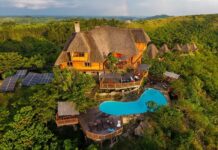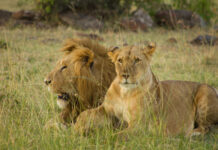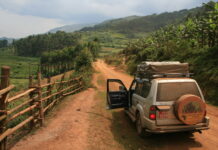Going on a gorilla safari is an interesting adventure offering a unique connection with one of our closest relatives in the animal kingdom. Mountain gorillas are found in the African continent (East Africa and Central Africa). If you are planning to go gorilla trekking in the mist, it is Rwanda, Uganda and Democratic Republic of Congo to consider as the only destinations to experience this adventure.
In East Africa it is Rwanda’s Volcanoes National Park and Uganda’s Bwindi Forest National Park and Mgahinga Gorilla National Park where you can encounter this experience. When you think of taking it from Rwanda be rest assured that the budget will be more higher compared to Uganda.
The gorilla permit costs $ 1500 per person during the year and if you want to book the discounted one you should travel between November to May and it costs $1050 per person but on conditions of visiting 02 or 03 Rwanda parks. More so, for those coming to Rwanda on conference and seminars can secure a permit of $1275 per person.
For the exclusive and behind the scene experience in Rwanda it is also available and here you can you choose the best luxury experience that you can encounter in the Volcanoes National Park.
- US$ 15,000 for personalized & exclusive mountain gorilla visits for a requested targeted Gorilla family,
- US$ 30,000 for a minimum of 3 visitors for 3 consecutive days (Behind the scenes)
Then for travelers looking at moderate gorilla safaris can choose to visit Uganda where a gorilla permit cost $800 per person whole year round though the distance from Entebbe in Uganda is far with drive of 09 hours, but with so many experience and flexibility of the tour operators we advise you to either start the gorilla journey from Kigali in Rwanda and it is like 2 – 3 hours drive to Bwindi or Mgahinga Gorilla National Parks.
Democratic Republic of Congo’s Virunga National Park stands to offer the best affordable gorilla permit and spacious Mikeno Lodge but due to the insecurity in the park the gorilla tourism is not on offer at this time.
Therefore, here are the reasons why a gorilla safari experience specially shouldn’t miss in your bucket list:
On a gorilla safari, you get a rare opportunity to see one of the most endangered animals on earth. There are about 1000 mountain gorillas left in the world. Unlike many other species, mountain gorillas cannot survive in captivity, which means you can only see them in the wild in the mountainous regions of Uganda, Rwanda and the Democratic Republic of Congo.
Among these three countries, Uganda and Rwanda offer the safest, most accessible and most sustainable gorilla trekking experiences. In Uganda, gorillas can only be found in Bwindi Impenetrable Forest and Mgahinga Gorilla National Park and in Rwanda, they can only be found in Volcanoes National Park. These gorillas live in carefully protected habitats and only a small number of people are allowed to visit them each day. Witnessing a gorilla in the wild especially from just a few meters away, is one of the most privileged and awe-inspiring wildlife encounters a human can have.
You get a deeply emotional and humbling encounter. Unlike watching wildlife from a safari vehicle, gorilla trekking is an immersive experience. You hike through dense jungle, sometimes for hours, following expert guides and trekkers who are trained to locate the gorillas. When you finally find a gorilla family, you are allowed to spend one hour in their presence.
This hour is life-changing. The sheer intelligence and emotion in the gorillas’ eyes are startling. They play, groom, nap and occasionally look at you with curiosity or indifference. You might encounter a Silverback (a mature male) weighing over 400 pounds, sitting calmly as he watches over his family. You may see babies climbing over their mothers or siblings, or mothers gently cradling their infants.
The connection is visceral. Many visitors report feeling a sense of kinship or even shedding tears. You are not watching a spectacle; you are quietly observing a family, one that shares 98% of human DNA. The silent in the wild, shared moment in nature leaves an indelible mark.
Support for Conservation and Local Communities. One of the most compelling reasons to do gorilla trekking in Uganda or Rwanda is the positive impact your visit can have. The governments and conservation organizations in both countries have created remarkably sustainable tourism models that directly benefit gorilla conservation and local communities.
A significant portion of the gorilla trekking permit fee which ranges from $800 in Uganda to $1,500 in Rwanda goes directly to protecting the gorillas including paying trekkers, researchers and veterinary teams.
Local communities benefit from jobs, infrastructure and revenue-sharing programs. Villages near the parks receive schools, clinics and clean water.
By going gorilla trekking, you are directly contributing to the protection of an endangered species and helping improve the lives of people who live near the parks. It is one of the few tourist activities in the world where your presence has such a clear and positive ripple effect.
Breathtaking Natural Landscapes. Gorilla trekking takes place in some of Africa’s most stunning landscapes. In Uganda, Bwindi Impenetrable Forest is a UNESCO World Heritage Site filled with ancient trees, misty hills, hidden waterfalls and an astonishing diversity of flora and fauna. Mgahinga Gorilla National Park which forms part of the larger Virunga range, features volcanic peaks and bamboo forests.
Rwanda’s Volcanoes National Park which is part of the Virunga Mountains chain, is a mosaic of mist-covered volcanoes, alpine meadows and dense rain forest. It is one of the most scenic protected areas in Africa. As you trek, you might spot golden monkeys, forest elephants, chameleons and countless bird species.
Even without the gorillas, these landscapes are worth visiting. The experience of hiking through otherworldly terrain, with birds calling overhead and a cool breeze brushing your face, is both invigorating and meditative.
Accessible and Adventurous. Gorilla trekking is not easy but it is accessible. While the hike can be physically challenging especially in Bwindi which is famously steep and rugged, the park authorities are accommodating. Trekking groups are organized based on fitness levels and porters are available to carry bags and assist hikers who need help. Some trails are shorter and stretchers are available for travelers with mobility challenges.
Rwanda with its better-developed infrastructure and shorter hikes, is often recommended for those seeking a slightly less strenuous experience. Uganda meanwhile offers more diverse terrain and a wider range of gorilla families to visit, often at a lower cost.
Regardless of the route you choose, the balance between adventure and accessibility makes gorilla trekking suitable for a wide range of travelers.
An Intimate, Non-Commercial Wildlife Experience. Unlike traditional safaris where large groups crowd around a sighting, gorilla trekking is highly regulated and intimate. Only 8 visitors are allowed per gorilla group per day and only for one hour. This low-impact model ensures the gorillas are not stressed and the forest ecosystem is preserved.
There are no fences, no feeding stations and no artificial interactions. The gorillas live wild and free and for your case, you are just a guest passing through. This purity and authenticity of the experience is increasingly rare in wildlife tourism.
In a world of over-tourism, gorilla trekking stands out as a respectful and ethical model that puts animal welfare first.
Photographic Opportunities Like No Other. If you are a photography enthusiast, gorilla trekking is a dream come true. The lighting in the rain forest can be dramatic with sunbeams piercing the mist, illuminating gorillas as they move or rest. Capturing a Silverback with dew clinging to his fur or a baby gorilla peeking from behind leaves can result in some of the most stunning wildlife portraits you will ever take.
Because you are often just a few meters away from the gorillas, even amateur photographers with smartphones can take remarkable shots. The experience provides a rare chance to capture emotion and connection in a non-zoo, non-captive settings something very few wildlife photographers ever achieve.
Cultural Immersion and Unique Travel Experiences. Gorilla trekking is often part of a larger East African adventure that includes cultural encounters, historical landmarks and other wildlife safaris. In Uganda, you can combine gorilla trekking with chimpanzee trekking, game drives in Queen Elizabeth National Park or a boat cruise on the Kazinga Channel. You can also visit the Equator, explore Kampala’s vibrant culture or take a whitewater rafting trip on the Nile.
In Rwanda, you can pair your trek with a visit to the Kigali Genocide Memorial, hike up a volcano or tour the beautiful Lake Kivu region. Rwandans are famously warm and welcoming and the country’s progress in development and sustainability is both moving and inspiring.
These additional activities provide a deeper context for your gorilla trekking adventure, allowing you to engage with the region on a cultural, historical and environmental level.
A Safe and Politically Stable Adventure. Both Uganda and Rwanda have made tremendous progress in terms of safety and infrastructure. Rwanda in particular, is widely considered one of the safest countries in Africa with clean cities, efficient transport and a strong commitment to eco-tourism.
Uganda, while more rugged, has also become increasingly stable and welcoming to tourists. Security in the trekking regions is a top priority and the parks are patrolled and carefully managed.
If you are new to Africa or have safety concerns, both countries offer excellent options for first-time or cautious travelers.
A Life-Changing Bucket List Achievement. Travelers often say they feel profoundly changed after gorilla trekking. There is something about being so close to our evolutionary cousins in their natural home that touches a deeper part of the human experience. It is a reminder of the fragility of life, the urgency of conservation and the deep interconnectedness of all living beings.
Unlike many tourist attractions, gorilla trekking is not about ticking a box or snapping a selfie. It is about slowing down, immersing yourself in nature and learning patience, humility and awe. This experience stays with you long after you have returned home and it is a story you will tell for the rest of your life and a memory that grows more meaningful with time.



